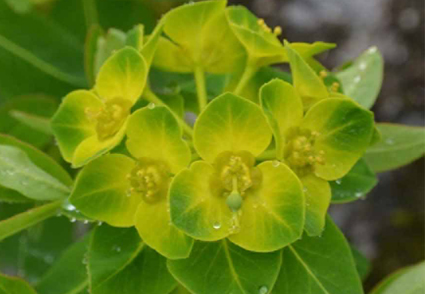Abstract
Euphorbia motuogensis M. T. Li, X. Z. Lan, H. P. Deng & W. L. Zheng, sp. nov., a new species from Motuo, Tibet, China, is described and illustrated here. It is closely similar to Euphorbia sikkimensis in having terete root, alternate leaves, well-developed pseudoumbellate inflorescence, cyathium, smooth and glaborus capsule, but Euphorbia motuogensis is clealy distinguishable by its pilose stems, involucral leaves color, secondary involucral leaves absent, cyathophylls number and color, and five similar glands. Furthermore, molecular phylogenetic analyses of sequences from both nuclear ribosomal ITS confirm that this species is distinct from morphologically similar species in this subgenus.
References
Horn, J.W., Ee, B.W.V., Morawetz, J.J., Riina, R., Steinmann, V.W. & Berry, P.E. (2012) Phylogenetics and the evolution of major structural characters in the giant genus Euphorbia L. (Euphorbiaceae). Molecular Phylogenetics & Evolution 63 (2): 305–326. https://doi.org/10.1016/j.ympev.2011.12.022
Higgins, D.G., Thompson, J.D., Gibson, T.J. (1994) The Clustal W: inproving the sensitivity of progressive multiple sequence alignment through sequence weighting, position-specific gap penalties and weight matrix choice. Nucleic Acids Research 22: 4673–4680. https://doi.org/10.1093/nar/22.22.4673
Ma, J.-S. & Gilbert, G.M. (2008) Euphorbia In: Wu, Z.Y., Raven, P.R. & Hong, D.Y. (eds.) Flora of China 11. Science Press, Beijing & Missouri Botanical Garden, St. Louis, pp. 288–313.
Ma, J.-S., Liu, Y & Wei, F.-N. (2013) A new species of Euphorbia (Euphorbiaceae) from Guangxi, China. Phytotaxa 87 (3): 45–49. https://doi.org/10.11646/phytotaxa.87.3.2
Posada, D. & Crandall, K.A. (1998) Modeltest: testing the model of DNA substitution. Bioinformatics 14: 817–818. https://doi.org/10.1093/bioinformatics/14.9.817
Peirson, J.A., Bruyns, P.V., Riina, R., Morawetz, J.J. & Berry, P.E. (2013) A molecular phylogeny and classification of the largely succulent and mainly African Euphorbia subg. Athymalus(Euphorbiaceae). Taxon 62 (6): 1178–1199. https://doi.org/10.12705/626.12
Riina, R., Peirson, J.A., Geltman, D.V., Molero, J., Frajman, B., Pahlevani, A., Barres, L., Morawetz, J., Salmaki, Y., Zarre, S., Kryukov, A., Bruyns, P. & Berry, P.E. (2013) A worldwide molecular phylogeny and classification of the leafy spurges, Euphorbia subgenus Esula (Euphorbiaceae). Taxon 62 (2): 316–342. https://doi.org/10.12705/622.3
Ronquist, F. & Huelsenbeck, J.P. (2003) MrBayes 3: Bayesian phylogenetic inference under mixed models. Bioinformatics 19: 1572–1574. https://doi.org/10.1093/bioinformatics/btg180
Steinmann, V.W. & Porter, J.M. (2002) Phylogenetic relationships in Euphorbieae (Euphorbiaceae) based on its and ndhf sequence data. Annals of the Missouri Botanical Garden 89 (4): 453–490. https://doi.org/10.2307/3298591
Tian, X.M., Wang, Q.Y. & Zhou, Y.F. (2018) Euphorbia section hainanensis (Euphorbiaceae), a new section endemic to the hainan island of china from biogeographical, karyological, and phenotypical evidence. Frontiers Plant Science 9 (2). https://doi.org/10.3389/fpls.2018.00660
White, T.J., Bruns, T., Lee, S. & Taylor, J. (1990) Amplification and direct sequencing of fungal ribosomal RNA genes for phylogenetics. In: Innis, M.A., Gelfand, D.H., Sninsky, J.J. & White, T.J. (Eds.) PCR Protocols: A Guide to Methods and Applications. Academic Press, New York, pp. 315–322.
ttps://doi.org/10.1016/B978-0-12-372180-8.50042-1
Yang, Y., Riina, R., Morawetz, J.J., Haevermans, T., Aubriot, X. & Berry, P.E. (2012) Molecular phylogenetics and classification of Euphorbia subgenus Chamaesyce (Euphorbiaceae). Taxon 61 (4): 764–789. https://doi.org/10.3732/ajb.1000496


